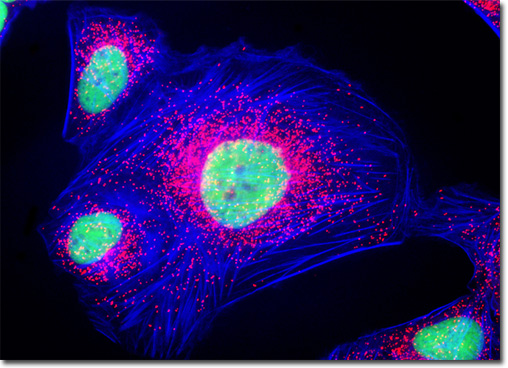Fluorescence Digital Image Gallery
Human Bone Osteosarcoma Cells (U-2 OS)
|
Histones are a group of proteins that were discovered in 1884 by German doctor Albrecht Kossel. The regulatory function of histones, which are found in the nuclei of eukaryotic cells, was not realized, however, until the 1990s. Prior to this time, the proteins were generally assumed to serve primarily as a type of packing for DNA to coil around. Yet, today histones are widely considered to be involved in gene regulation, the physical and functional alterations that occur in chromatin during cell division, and the transcription of DNA. Histones are strongly alkaline and rich in the amino acids lysine and arginine. Five major subtypes of histone proteins have been described. Nuclear histone proteins were targeted in the culture of human osteosarcoma cells presented above with mouse anti-histone (pan) monoclonal antibodies, which were imaged with goat anti-mouse Fab fragments conjugated to the cyanine dye, Cy2 (labeling the nucleus). The specimen was simultaneously labeled for peroxisomes with Rhodamine Red conjugated to goat secondary antibodies that target rabbit anti-PMP 70 (peroxisomal membrane protein 70). Alexa Fluor 350 conjugated to phalloidin was utilized to counterstain the cytoskeletal F-actin network. Images were recorded in grayscale with a QImaging Retiga Fast-EXi camera system coupled to an Olympus BX-51 microscope equipped with bandpass emission fluorescence filter optical blocks provided by Omega Optical. During the processing stage, individual image channels were pseudocolored with RGB values corresponding to each of the fluorophore emission spectral profiles. |
© 1995-2025 by Michael W. Davidson and The Florida State University. All Rights Reserved. No images, graphics, software, scripts, or applets may be reproduced or used in any manner without permission from the copyright holders. Use of this website means you agree to all of the Legal Terms and Conditions set forth by the owners.
This website is maintained by our
|
